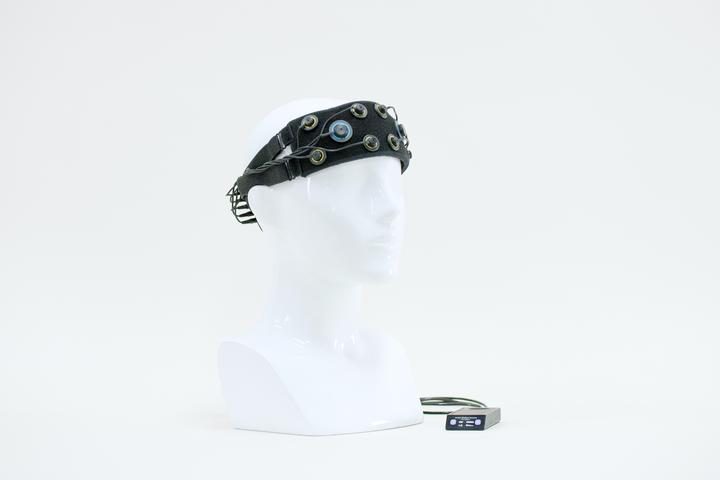
Publications using the OctaMon
Prefrontal Cortex Activity and Gait in Parkinson's Disease With Cholinergic and Dopaminergic Therapy
Degradation of striatal dopamine in Parkinson's disease (PD) may initially be supplemented by increased cognitive control mediated by cholinergic mechanisms. Shift to cognitive control of walking can be quantified by prefrontal cortex activation. …
Prefrontal Cortex Activity During Walking: Effects of Aging and Associations With Gait and Executive Function
Background: Declines in gait parameters are common with aging and more pronounced in tasks with increased executive demand. However, the neural correlates of age-related gait impairments are not fully understood yet. Objectives: To investigate (a) …
Prefrontal Cortical Activation with Open and Closed-Loop Tactile Cueing When Walking and Turning in Parkinson Disease: A Pilot Study
Background and Purpose: Gait and turning impairments are common in people with Parkinson disease (PwPD). Tactile cues delivered in open- or closed-loop modalities may improve gait and turning in PwPD, but underlying mechanisms are unclear. Attention …
Reliability of fNIRS for noninvasive monitoring of brain function and emotion in sheep
The aim of this work was to critically assess if functional near infrared spectroscopy (fNIRS) can be profitably used as a tool for noninvasive recording of brain functions and emotions in sheep. We considered an experimental design including …
Self-health monitoring and wearable neurotechnologies
Brain-computer interfaces and wearable neurotechnologies are now used to measure real-time neural and physiologic signals from the human body and hold immense potential for advancements in medical diagnostics, prevention, and intervention. Given the …
The effects of fast and slow yoga breathing on cerebral and central hemodynamics
Background: Yoga breathing has shown to impose significant cardiovascular and psychological health benefits. Objective: The mechanism (s) responsible for these health benefits remain unclear. The aim of the present study was to assess the differences …
Thesis The Voice of Primates : Neuro-evolutionary Aspects of Emotions NEURO-EVOLUTIONARY ASPECTS OF EMOTIONS
Rightly emphasized by Pascal Belin “Voices are everywhere”. From music to social conversation, the human voice has indeed the extraordinary power to communicate our everyday emotions. Shaped by millions of years of evolution, the vocal recognition of …
Which obstacle attributes place additional demands on higher-level cognitive function in patients with Parkinson's disease?
Background: Previous reports show that patients with Parkinson's disease (PD) rely on prefrontal activation to compensate for impaired motor function during complex activities such as obstacle negotiation. However, the influence of the properties of …
The Association between Prefrontal Cortex Activity and Turning Behavior in People with and without Freezing of Gait
Turning elicits Freezing of Gait (FoG) episodes in people with Parkinson's disease (PD) and is thought to require higher cortical control compared to straight ahead gait. Functional near infrared spectroscopy (fNIRS) has been used to examine …
Impact of carbohydrate ingestion on cognitive flexibility and cerebral oxygenation during high-intensity intermittent exercise: A comparison between maple products and usual carbohydrate solutions
Background: The aim of this study was to compare the effects of carbohydrate (CHO) drinks (6% per volume) sweetened with maple (syrup or sap) to a commercial sports drink, glucose, and a control solution (water) on cognitive flexibility during …
An overview of the feasibility of permanent, real-time, unobtrusive stress measurement with current wearables
Negative consequences of stress are a pervasive problem in our modern society. Recent developments in wearable lifestyle hardware have led to unobtrusive, sensor-packed, always-on devices that might finally be able to continuously monitor biosignals …
FNIRS and neurocinematics
In the overlap between Human-Computer Interaction (HCI) and Cinematics, sits an interest in physiological responses to experiences. Focusing particularly on brain data, Neurocinematics has emerged as a research field using Brain-Computer Interface …
Neurophysiological Variations in Food Decision-Making within Virtual and Real Environments
Simple lifestyle changes such as improving one's diet and getting sufficient exercise could significantly reduce the risk of developing obesity and related diseases such as diabetes, heart disease, stroke, and cancer. However, changing eating …
Evaluation of cortical neuroexcitation in urinary urgency using simultaneous near infrared spectroscopy of the brain and bladder with quantification of sensation
© 2019 SPIE Background: Overactivity of the bladder (OAB) affects 20% of people globally, causing urgency to void and incontinence of urine (UI)). OAB has a multi-factorial causation. Problematically current tests are invasive and provide limited …
Effects of acute transcutaneous vagus nerve stimulation on emotion recognition in adolescent depression
BackgroundTranscutaneous vagus nerve stimulation (tVNS) is a promising therapeutic option for major depressive disorder (MDD) in adults. Alternative third-line treatments for MDD in adolescents are scarce. Here we aimed to assess the effects of acute …
Exercise intensity influences prefrontal cortex oxygenation during cognitive testing
Activation changes in the prefrontal cortex (PFC) regions have been linked to acute exercise-induced improvements in cognitive performance. The type of exercise performed may influence PFC activation, and further impact cognitive function. The …
A Review on the Use of Wearable Functional Near-Infrared Spectroscopy in Naturalistic Environments
The development of novel miniaturized wireless and wearable functional near-infrared spectroscopy (fNIRS) devices has paved the way for new functional brain imaging that could revolutionize the cognitive research fields. Over the past few decades, …
Concurrent changes of brain functional connectivity and motor variability when adapting to task constraints
In behavioral neuroscience, the adaptability of humans facing different constraints has been addressed on one side at the brain level, where a variety of functional networks dynamically support the same performance, and on the other side at the …
The present and future use of functional near-infrared spectroscopy (fNIRS) for cognitive neuroscience
The past few decades have seen a rapid increase in the use of functional near-infrared spectroscopy (fNIRS) in cognitive neuroscience. This fast growth is due to the several advances that fNIRS offers over the other neuroimaging modalities such as …
Dynamics of the human brain network revealed by time-frequency effective connectivity in fNIRS
© 2017 Optical Society of America. Functional near infrared spectroscopy (fNIRS) is a promising neuroimaging method for investigating networks of cortical regions over time. We propose a directed effective connectivity method (TPDC) allowing the …